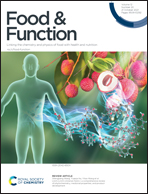Protective effect and mechanism of chitooligosaccharides on acetaminophen-induced liver injury†
Abstract
Currently, drug-induced liver injury caused by acetaminophen (APAP) is the second leading cause of human liver transplantation. The only clinical antidote treatment for APAP-induced liver injury is N-acetyl-L-cysteine (NAC), which has many side effects. Chitooligosaccharides (COS) are processed from naturally occurring chitin through chemical desalting and deproteinization, biological enzymatic hydrolysis and other processes. In this study, we constructed in vitro and in vivo models of APAP-induced liver injury to study COS of two molecular weights (MWs), which are COST (MW ≤ 1000 Da) and COSM (MW ≤ 3000 Da). The results showed that COST and COSM can significantly reduce the levels of serum ALT and AST and liver MDA, TNF-α, IL-1β and IL-6, and increase the levels and activity of GSH, SOD, GSH-Px and CAT. A mechanistic study found that COST and COSM can significantly reduce the expression of liver CYP2E1, Keap1, p-ASK1/ASK1, p-MKK4/MKK4, p-JNK/JNK, Caspase-3 and Bax and increase the expression of Nrf2, HO-1, eNOS, SOD and Bcl-XL. COST and COSM can inhibit toxic APAP metabolism, inhibit oxidative damage and the apoptosis pathway, increase activation of the liver antioxidant pathway, and ultimately ameliorate APAP-induced liver oxidative damage.



 Please wait while we load your content...
Please wait while we load your content...